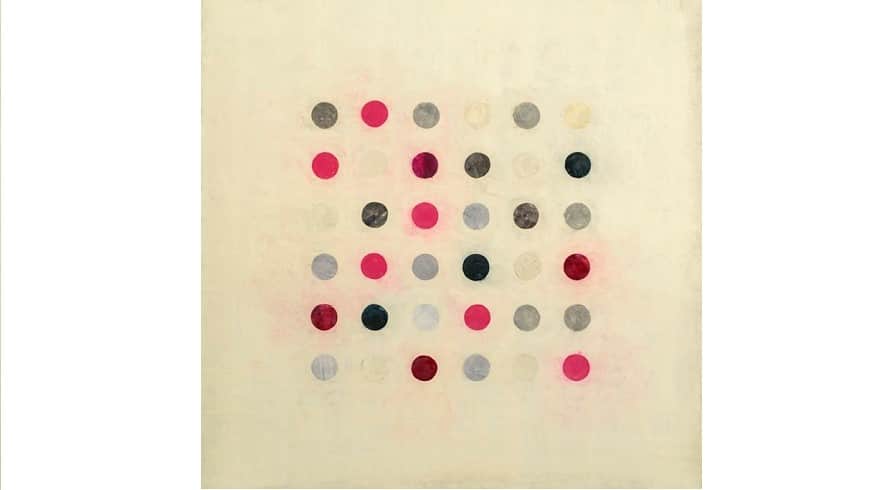Tracey Adams is an abstract painter who has been an exhibiting artist for more than 30 years. She has participated in more than 150 solo and group exhibitions in the United States and abroad. Her work is included in the collections of the Bakersfield Art Museum, Crocker Museum, Hunterdon Art Museum, Monterey Museum of Art, Fresno Art Museum, Tucson Art Museum and Santa Barbara Museum of Art.
Below is a recent interview with her about her process, her family life, words of advice for emerging artists and her thoughts on social media:
Brenda Hope Zappitell: Can you tell us about your process?
Tracey Adams: I have so many. The paintings in my current shows, Patterns of Infinity, began with sheets of Japanese paper that were dipped in molten pigmented wax. I hand cut hundreds of circles from these sheets in a variety of colors. I layered a wood panel with many layers of pigmented wax, scraping and heating, creating a quiet, still surface on which the circles would become active. Once that was done, I placed the circles on the surface, let them sit, moved them around and finally decided where I would adhere them with wax. I use oil-based pigment sticks on the surface. There are subtle additions/deletions made over the course of several weeks, which is when the final painting began to take shape.
BHZ: What series are you working on now and how did it come about?
TA: I’m working on a series called Folded. Using discarded encaustic monotypes made on Japanese papers, I fold each paper into a shape. I began the series on June 1, around the time I completed work on four exhibitions. Each day, I folded one of these discarded pieces using the numerical day of the month to determine the number of folds in the piece. For example, the piece made on June 5 has five folds. Math, patterns and formulae have always been an interest and component present in my work. I was exhausted from working on these shows for a year and needed a break, yet didn’t want to stop working completely. Paper, especially collage, has always been my default and comfort when I need a rest from painting in the studio.
BHZ: You seem to work mostly in encaustic. Can you explain why that is your preferred medium?
TA: I’ve worked with beeswax and encaustic, pigmented and clear, for the last 17 years. I also work with acrylic (2011-2013), drawing media like graphite and have been a printmaker since I was 16. I enjoy the experimentation that comes with combining different media — the discovery keeps things fresh for me. I love the texture and translucency of beeswax/encaustic; plus working with it allows the same spontaneity to occur that I find when making monotypes.
BHZ: Please, tell us about your family life.
TA: I have been married to my husband for 32 years. He is extremely supportive and encouraging of my work as an artist, helping with all aspects of running the house; I’ve been able to attend artist residencies, workshops and conferences because of this. We have a son and a 5-year-old granddaughter. They live out of the area so we don’t see them very often, but my granddaughter is a budding artist.
BHZ: You have been a professional artist for quite some time. Do you have any words of advice for people who are just starting out in the business professionally?
TA: Work hard and diligently. Find your own voice! Be patient — growth and excellence doesn’t come quickly. Be willing to experiment and fail. Be tenacious and more patient. Get involved in whatever capacity you can to achieve the goals you want. If you’re able to volunteer at a gallery or museum, it’s a great way to meet the individuals you’ll want to have in your circle. Enter appropriate juried exhibitions and get your work seen by the best people you can. Be patient. Go back to the first point and repeat.
BHZ: Do you think social media can play a role in the advancement of an artist’s career? If so, how?
TA: Yes, I’ve heard of artist friends who’ve made gallery connections because their work was seen on Facebook. I live in Monterey, California, in a rural area two hours south of San Francisco. While I’m able to visit the city every six weeks or so, I often feel isolated from what’s going on in the art world and beyond. Social media has made the world feel much smaller; it enables me to see a lot of art and trends in art being shown all over the world. Like most of us who participate in Facebook, I have many art “friends” whom I’ve never met. There are small specialty art groups within Facebook where wonderfully educational threads of conversation take place. My scope of learning has increased exponentially — there’s always so much to read and learn. I have yet to be contacted by a gallery or curator through social media, but I have participated in several shows as a result of my work being seen initially on Facebook.




